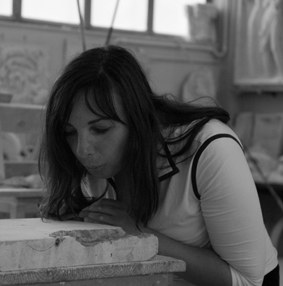Bio
 English version see below
English version see below
< ph Emanuela Casagrande
Gli esordi di Angela Corti sono avvenuti negli anni ‘90, ancor prima di intraprendere gli studi accademici con le prime incisioni calcografiche ad acquaforte. Dall’incisione con morsura ad acido, ha sentito il bisogno del segno diretto su metallo e dell’utilizzo di una carta lavorata a mano che, una volta stampata, creasse un rilievo, un principio di scultura bidimensionale. E probabilmente è proprio il contrasto di luce tra segno diretto e rugosità del supporto cartaceo, tra bianco e nero, a favorire il passaggio alla scultura. Viene immediatamente attratta dai materiali, le forme plastiche con riferimenti espressivi, che rinviano tanto al concettuale che all’astratto informale. Ha scelto da subito la linea non figurativa, che mantiene tanto nell’incisione, quanto nella scultura.
La sua ricerca consiste nella lavorazione di blocchi di pietra, compiendo un’operazione di decostruzione-ricostruzione: li frammenta, per poi ricomporli; dando alla materia nuova forma, riunendo i pezzi, cucendo le pietre con un filo metallico che trattiene i frammenti . Talvolta alterna le pietre fratturate e ricomposte, con sculture in marmo più plastiche e prive di ferite, quasi ad innalzare il mondo divino in uno spazio eterno, lontano dalle fratture del mondo terreno. Della pietra è attratta per i suoi segni, le venature, le variazioni cromatiche, l’alternanza di superfici lisce, rugose e cristalline. Tutto ciò che si frange, pur conservando i segni della rottura, della frammentarietà, può avere nuova forma, nuova vita.
Si diploma all’Accademia di belle arti di Brera a Milano (Italia) nel 2003, dove ha appreso le tecniche pittoriche, calcografiche e scultoree con i docenti Giuseppe Maraniello, Davide Boriani, Paolo Minoli, Massimo Pellegrinetti, Andrea Del Guercio e Luce Delhove. Ha successivamente migliorato le tecniche d’incisione presso lo studio di Luigi Corsini e di scultura presso la scuola Vantini a Rezzato (Italia). Ha studiato anche lingue straniere presso l’Università Cattolica di Brescia .
English version:
Angela Corti beginnings occurred in the 90s, before starting on her academic studies with the first etchings engraving. From engraving with etching acid, she felt the need to act directly on the metal and use a hand-made paper which, when printed, would create a relief, just a beginning of two-dimensional sculpture. It’s probably just the lighting contrast between direct sign and roughness of paper, between black and white, to facilitate the transition to sculpture. She was immediately attracted by materials, plastic shapes with expressive references, referring to both the conceptual and informal abstract. She chooses immediately the non-figurative style, that she keeps both in the engraving and sculpture.
Her research is in the processing of stone blocks, making operation of deconstruction-reconstruction: she fragments them, then put them back together; giving new a form, bringing together the pieces, sewing the stones with a wire that holds the fragments. Sometimes she alternates fractured and recomposed stones, with more plastic marble sculptures free from wounds, as if to raise the divine world in the eternal space, away from the earthly world fractures. The stone attracts her to its signs, the grain, the color variations, the alternation of smooth surfaces, rough and crystal. All that is broken, while preserving the signs of rupture, of fragmentation, can have new forms, a new life.
She obtained a degree at the Academy of Fine Arts of Brera, Milan (Italy), in 2003, where she learned the painting, sculpture and engraving techniques with Professors Giuseppe Maraniello, Davide Boriani, Paolo Minoli, Massimo Pellegrinetti, Andrea Del Guercio and Luce Delhove. She subsequently improved engraving techniques at the studio of Luigi Corsini and sculpture at the Vantini School in Rezzato (Italy). She also studied foreign languages at the Catholic University of Brescia .
Solo Exhibitions Group Exhibitions Teaching Museum-Private Collections